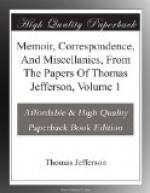In the last volume of the Connoissance des Terns, you will find the tables for the planet Herschel. It is a curious circumstance, that this planet was seen thirty years ago by Mayer, and supposed by him to be a fixed star. He accordingly determined a place for it, in his catalogue of the zodiacal stars, making it the 964th of that catalogue. Bode, of Berlin, observed in 1781, that this star was missing. Subsequent calculations of the motion of the planet Herschel show, that it must have been, at the time of Mayer’s observation, where he had placed his 964th star.
Herschel has pushed his discoveries of double stars, now, to upwards of nine hundred, being twice the number of those communicated in the Philosophical Transactions. You have probably seen, that a Mr. Pigott had discovered periodical variations of light in the star Algol. He has observed the same in the n of Antinous, and makes the period of variation seven days, four hours, and thirty minutes, the duration of the increase sixty-three hours, and of the decrease thirty-six hours. What are we to conclude from this? That there are suns which have their orbits of revolution too? But this would suppose a wonderful harmony in their planets, and present a new scene, where the attracting powers should be without, and not within the orbit. The motion of our sun would be a miniature of this. But this must be left to you astronomers.
I went some time ago to see a machine, which offers something new. A man had applied to a light boat, a very large screw, the thread of which was a thin plate, two feet broad, applied by its edge spirally round a small axis. It somewhat resembled a bottle-brush, if you will suppose the hairs of the bottle-brush joining together, and forming a spiral plane. This, turned on its axis in the air, carried the vessel across the Seine. It is, in fact, a screw which takes hold of the air and draws itself along by it: losing, indeed, much of its effort by the yielding nature of the body it lays hold of, to pull itself on by. I think it may be applied in the water with much greater effect, and to very useful purposes Perhaps it may be used also for the balloon.
It is impossible but you must have heard long ago of the machine for copying letters at a single stroke, as we had received it in America before I left there. I have written a long letter to my nephew, in whose education I feel myself extremely interested. I shall rely much on your friendship for conducting him in the plan I mark out for him, and for guarding him against those shoals, on which youth sometimes shipwreck. I trouble you to present to Mr. Wythe my affectionate remembrance of him, and am with very great esteem, Dear Sir,
your friend and servant,
Th: Jefferson.
LETTER CXIX.—TO DR. FRANKLIN, October 5,1785
TO DR. FRANKLIN.
Paris, October 5,1785.




